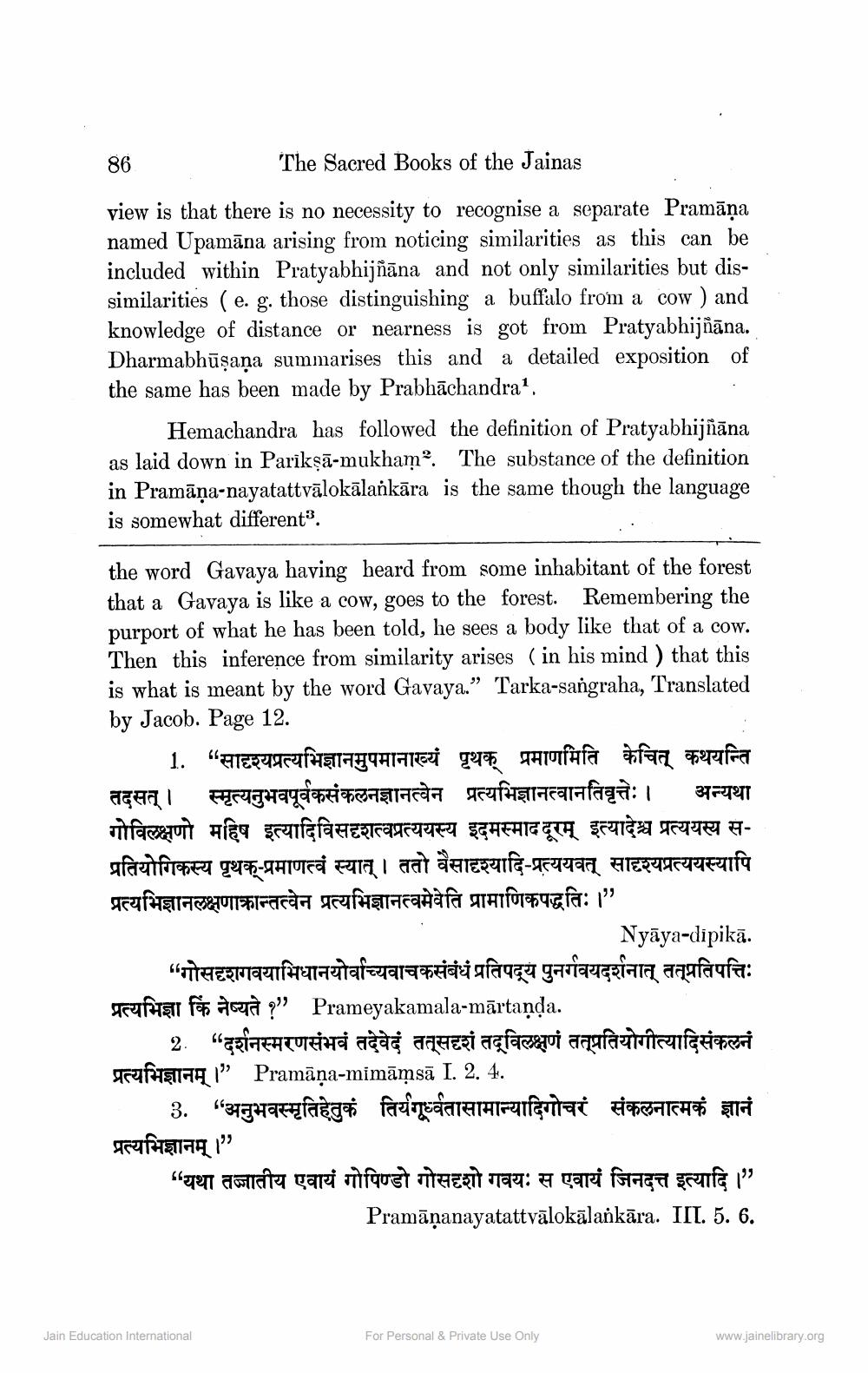________________
86
The Sacred Books of the Jainas
view is that there is no necessity to recognise a separate Pramāņa named Upamāna arising from noticing similarities as this can be included within Pratyabhijñāna and not only similarities but dissimilarities (e. g. those distinguishing a buffalo from a cow ) and knowledge of distance or nearness is got from Pratyabhijñāna. Dharmabhūṣaṇa summarises this and a detailed exposition of the same has been made by Prabhachandra1.
Hemachandra has followed the definition of Pratyabhijñāna as laid down in Parikṣa-mukham2. The substance of the definition in Pramāṇa-nayatattvālokālankāra is the same though the language is somewhat different".
the word Gavaya having heard from some inhabitant of the forest that a Gavaya is like a cow, goes to the forest. Remembering the purport of what he has been told, he sees a body like that of a cow. Then this inference from similarity arises (in his mind) that this is what is meant by the word Gavaya." Tarka-sangraha, Translated by Jacob. Page 12.
अन्यथा
1. “ सादृश्यप्रत्यभिज्ञानमुपमानाख्यं पृथक् प्रमाणमिति केचित् कथयन्ति तदसत् । स्मृत्यनुभवपूर्वकसंकलनज्ञानत्वेन प्रत्यभिज्ञानत्वानतिवृत्तेः । गोविलक्षण महिष इत्यादिविसदृशत्वप्रत्ययस्य इदमस्माद दूरम् इत्यादेश्च प्रत्ययस्य स - प्रतियोगिकस्य पृथक्-प्रमाणत्वं स्यात् । ततो वैसादृश्यादि - प्रत्ययवत् सादृश्यप्रत्ययस्यापि प्रत्यभिज्ञानलक्षणाक्रान्तत्वेन प्रत्यभिज्ञानत्वमेवेति प्रामाणिकपद्धतिः ।"
Nyāya-dipika. “गोसदृशगवयाभिधानयोर्वाच्यवाचकसंबंधं प्रतिपद्य पुनर्गवयदर्शनात् तत्प्रतिपत्तिः प्रत्यभिज्ञा किं नेष्यते ?” Prameyakamala-mārtanda.
2. “ दर्शनस्मरणसंभवं तदेवेदं तत्सदृशं तदूविलक्षणं तत्प्रतियोगीत्यादिसंकलनं प्रत्यभिज्ञानम् ।” Pramāna-mimāmsā I. 2. 4.
3. " अनुभवस्मृतिहेतुकं तिर्यगूर्ध्वता सामान्यादिगोचरं संकलनात्मकं ज्ञानं प्रत्यभिज्ञानम् ।”
"यथा तज्जातीय एवायं गोपिण्डो गोसदृशो गवयः स एवायं जिनदत्त इत्यादि । "
Pramānanayatattvālokalankāra. III. 5. 6.
Jain Education International
For Personal & Private Use Only
www.jainelibrary.org




